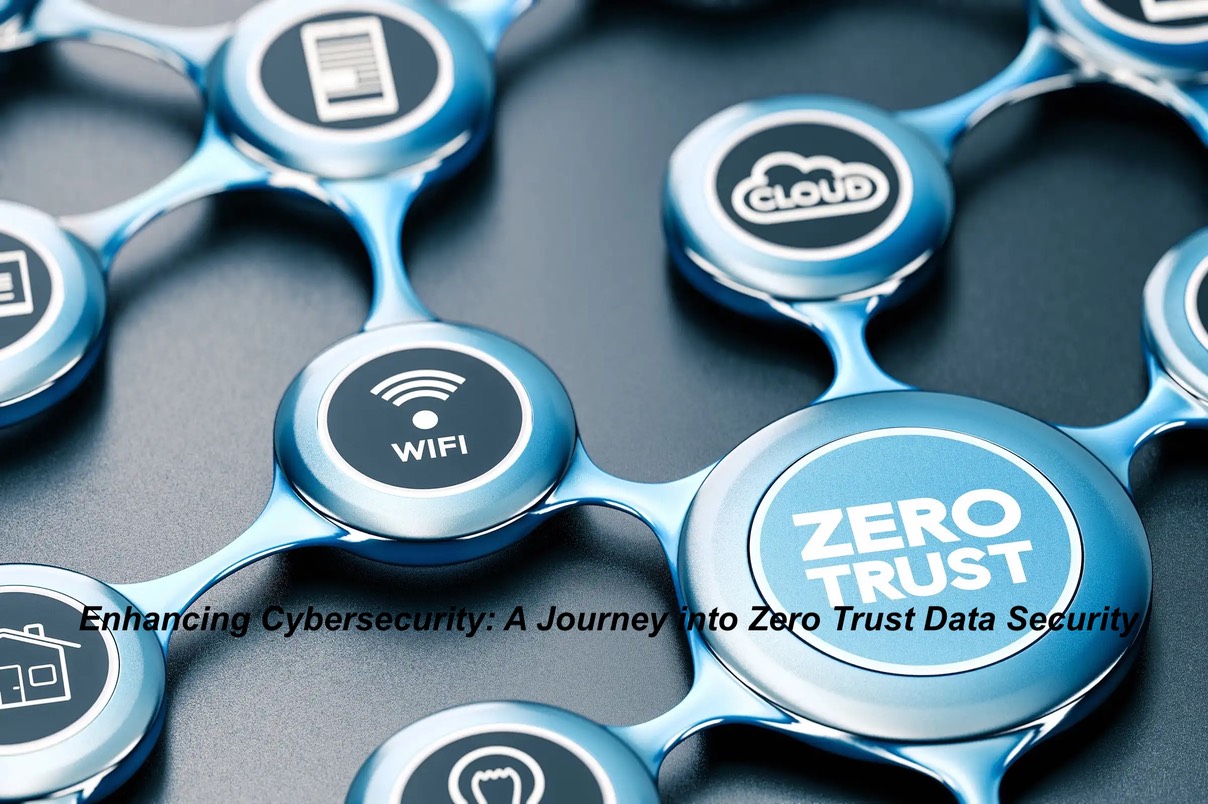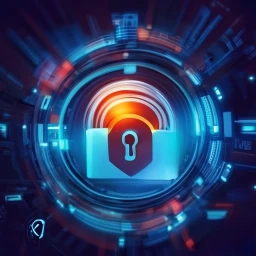
In today's digital landscape, cyber threats are evolving at an unprecedented rate, posing significant challenges to organizations worldwide. Ransomware attacks alone surged by a staggering 105 percent globally in 2021, as reported by SonicWall. From critical infrastructure to supply chain disruptions, the impact of these attacks reverberates across industries, endangering crucial business operations.
Despite substantial investments in traditional security measures, attackers continue to breach defenses and access sensitive data, highlighting the urgent need for a paradigm shift in cybersecurity strategies.
Why Zero Trust Data Security Matters

Enter Zero Trust Data Security—a revolutionary approach that challenges conventional notions of trust within network architectures. While Zero Trust is commonly associated with network security, its principles extend to data security and overall security architecture.
In this blog post, we'll explore the significance of implementing Zero Trust Data Security within your organization, dissect its core components, and provide actionable insights on how to kickstart your journey toward enhanced cybersecurity resilience.
Key Takeaways:
1. Understanding the Need: Delve into the rationale behind adopting Zero Trust Data Security and its pivotal role in mitigating modern cyber threats.
2. Exploring Zero Trust Architecture: Unpack the fundamental elements of a Zero Trust architecture and how they contribute to a robust security posture.
3. Getting Started: Practical tips and guidelines for initiating your organization's Zero Trust Data Security initiative, tailored for IT Security experts.
4. Incident Response Essentials: Discover the essential principles of effective incident response, empowering you to navigate and mitigate security incidents with confidence.
Assumptions and Audience
This blog post is crafted with IT Security experts in mind, including Chief Information Officers (CIOs), Chief Information Security Officers (CISOs), Vice Presidents, Architects, Engineers, Administrators, and Analysts responsible for safeguarding their organization's critical data assets.
While targeted towards technical readers with a basic understanding of security and backup technologies, the insights shared herein are valuable to anyone seeking to bolster their cybersecurity defenses and embrace a proactive approach to data security.
Whether you align with our assumptions or not, we invite you to embark on this enlightening journey into the realm of Zero Trust Data Security.

Explore the imperative of Zero Trust Data Security, unravel legacy backup challenges, navigate data privacy regulations, and reap the benefits of a proactive cybersecurity approach in this enlightening chapter.
Recognizing the Need for Zero Trust Data Security
In today's digital landscape, where cyber threats loom large and traditional security measures fall short, the need for Zero Trust Data Security has never been more apparent. In this chapter, we delve into the core principles of Zero Trust, dissect legacy backup challenges, explore data security and privacy issues, and unveil the myriad benefits of adopting a Zero Trust architecture.
Defining Zero Trust Data Security
Zero Trust Data Security operates on the foundational principle of "never trust, always verify." Unlike traditional perimeter-based defenses that rely on delineating internal and external networks, Zero Trust challenges the notion of implicit trust within networks. Under this model, every user, device, and resource must undergo continuous verification, ensuring that access is granted only on a need-to-know basis and for a limited duration.
Understanding Legacy Backup Challenges
Legacy backup architectures once considered a bastion of data protection, are now vulnerable to modern cyber threats, particularly ransomware attacks. Traditional backup strategies, reliant on centralized servers and network storage, are ill-equipped to withstand the sophisticated tactics employed by cybercriminals. From encrypting online backups to rendering recovery operations futile, ransomware poses a formidable challenge to organizations relying on legacy backup solutions.
Exploring Data Security and Privacy Issues
Data is the lifeblood of modern organizations, making it a prime target for cybercriminals. Beyond safeguarding data integrity and availability, organizations must navigate a labyrinth of privacy regulations, including GDPR and CCPA, which mandate stringent data protection measures. As data traverses various environments, including backups, ensuring "privacy by design" and "privacy by default" becomes imperative to compliance and risk mitigation.
Reaping the Benefits of Zero Trust Architecture
The benefits of embracing a Zero Trust Data Security architecture are manifold. By fortifying critical data against ransomware attacks, organizations can mitigate the risk of data loss and extortion, enabling swift recovery without succumbing to ransom demands. Security teams gain the confidence to leverage secured backup data for forensic analysis and expedited recovery operations, bolstering their incident response capabilities.
Application owners, entrusted with maintaining business continuity, can rest assured knowing that their data is shielded within a Zero Trust enclave, ready to withstand the onslaught of cyber threats. Moreover, organizational leaders, from CIOs to CFOs, can derive peace of mind knowing that their ransomware recovery plans are underpinned by a robust Zero Trust architecture, thereby minimizing financial liabilities and safeguarding brand reputation.
As we embark on this journey into the realm of Zero Trust Data Security, let us embrace the transformative power of proactive cybersecurity measures, safeguarding our data assets with unwavering vigilance and resilience.
Stay tuned as we unravel the intricacies of Zero Trust Data Security and empower you to navigate the evolving threat landscape with confidence and clarity.

Zero Trust Data Protection: Safeguarding Your Digital Assets
Embark on a journey to fortify your organization's cybersecurity defenses with Zero Trust Data Protection solutions. Explore ransomware investigation, sensitive data discovery, and orchestrated application recovery strategies to navigate the digital landscape with resilience and resolve.
In an era where cyber threats loom large and traditional security measures falter Zero Trust Data Protection emerges as a beacon of resilience and fortitude. In this chapter, we embark on a journey to unravel the complexities of Zero Trust Data Protection solutions, delve into the intricacies of ransomware investigation, illuminate the process of sensitive data discovery, and unveil the orchestrated application recovery strategies that empower organizations to navigate the tumultuous seas of cyber threats with confidence and clarity.
Exploring Zero Trust Data Protection
Zero Trust Data Protection stands at the vanguard of modern cybersecurity, offering a holistic approach to data management across hybrid and multi-cloud environments. By seamlessly integrating backup, recovery, analytics, and compliance functionalities into a unified software platform, Zero Trust Data Protection delivers unparalleled intelligence and resilience, safeguarding critical data assets against the relentless tide of cyber threats.
Key capabilities of Zero Trust Data Protection include:
· Service-Level Agreement (SLA) Automation: Streamline backup operations and ensure compliance with organizational SLAs through automated policy enforcement across diverse workloads.
· Rapid Recovery: Empower organizations to achieve near-zero Recovery Time Objectives (RTOs) by enabling swift data recovery through intuitive search and mount functionalities.
· API-First Approach: Harness the power of automation and integration through robust API capabilities, enabling seamless interoperability with existing tools and workflows.
· Secure by Design: Leverage immutable backup data to fortify defenses against ransomware attacks and other malicious threats, ensuring the integrity and availability of critical data assets.
Ransomware Investigation: Navigating the Threat Landscape
Ransomware attacks pose a significant threat to organizations worldwide, demanding swift and decisive action to contain and mitigate their impact. With ransomware investigation tools at their disposal, organizations gain invaluable insights into the scope and severity of ransomware attacks, enabling expedited incident response and recovery efforts.
Key capabilities of ransomware investigation tools include:
· Identifying Anomalies: Analyze backup data for aberrant behavior and suspicious changes, providing early detection and alerting mechanisms to thwart ransomware attacks.
· Assessing Impact: Determine the extent of data encryption or corruption caused by ransomware attacks, enabling organizations to quantify the blast radius and prioritize recovery efforts.
· Facilitating Rapid Response: Leverage actionable insights to orchestrate targeted recovery operations, restoring affected files and applications with surgical precision to minimize downtime and business disruption.
Case Study: ASL Airlines France
ASL Airlines France, a prominent cargo and passenger airline, faced mounting cybersecurity challenges amidst the escalating threat landscape. With Rubrik's Ransomware Investigation solution, ASL Airlines fortified its defenses against ransomware attacks, achieving substantial operational savings and enhancing its cyber resilience posture. By automating threat detection and accelerating recovery operations, ASL Airlines mitigated the risk of downtime and reputational damage, ensuring uninterrupted business continuity in the face of cyber adversity.
Sensitive Data Discovery: Illuminating the Data Landscape
In an age of regulatory scrutiny and heightened privacy concerns, the discovery and classification of sensitive data emerge as imperative mandates for organizations seeking to uphold compliance and mitigate data breach risks. With sensitive data discovery solutions, organizations gain unparalleled visibility into their data repositories, enabling proactive risk mitigation and compliance assurance.
Key capabilities of sensitive data discovery solutions include:
· Automated Policy Enforcement: Define and enforce data protection policies to safeguard Personally Identifiable Information (PII) and other sensitive data assets across diverse environments.
· Assessing Data Exposure: Identify instances of data exposure and unauthorized access, enabling organizations to preemptively remediate vulnerabilities and mitigate breach risks.
· Simplifying Compliance: Streamline compliance efforts by documenting data lineage and access controls, ensuring adherence to regulatory mandates such as GDPR, PCI-DSS, HIPAA, and GLBA.
Case Study: City of Sioux Falls
The City of Sioux Falls, a bustling metropolitan hub, grappled with the challenges of data sprawl and regulatory compliance in its quest to protect citizen and employee data. With Rubrik's Sensitive Data Discovery solution, the city achieved unparalleled visibility into its data landscape, identifying and mitigating data exposure risks with unprecedented efficiency. By automating data governance processes and enhancing regulatory compliance, the City of Sioux Falls safeguarded its reputation and minimized the risk of data breaches, ensuring the confidentiality and integrity of sensitive information.
Incident Containment and Orchestrated Application Recovery: Fortifying Resilience
In the wake of cyberattacks and disaster events, incident containment and orchestrated application recovery emerge as linchpins of organizational resilience and continuity. By leveraging advanced incident containment capabilities, organizations can swiftly mitigate the impact of ransomware attacks and prevent malware reinfection during recovery operations. Furthermore, orchestrated application recovery solutions enable seamless failover/failback processes, ensuring business services remain available and resilient in the face of adversity.
Zero Trust Data Protection solutions offer a holistic framework for safeguarding critical data assets against evolving cyber threats. By embracing proactive measures such as ransomware investigation, sensitive data discovery, and orchestrated application recovery, organizations can fortify their defenses, enhance their resilience, and navigate the digital landscape with confidence and clarity.
Stay tuned as we delve deeper into the realm of cybersecurity and empower organizations to navigate the complexities of the digital age with resilience and resolve.

Zero Trust Data Security: Building Resilience from the Ground Up
Discover the core components of Zero Trust Data Security and learn how machine learning, data classification, threat hunting, and automated recovery workflows combine to fortify organizations against modern cyber threats.
In the ever-evolving landscape of cybersecurity, the principles of Zero Trust architecture stand as a beacon of resilience and adaptability. In this chapter, we delve into the foundational components of Zero Trust Data Security, exploring the integration of machine learning, data classification, threat hunting, and automated recovery workflows to fortify organizations against modern cyber threats.
Understanding the Core Components of Zero Trust Architecture
Zero Trust architecture represents a paradigm shift in cybersecurity, rejecting the traditional perimeter-based security model in favor of a more granular and dynamic approach. At its core, Zero Trust Data Security emphasizes the need for continuous verification and validation of user identities, devices, and applications, irrespective of their location or network proximity. By adopting a zero-trust mindset, organizations can mitigate the risk of data breaches and unauthorized access, ensuring robust data protection in today's interconnected digital ecosystem.
Leveraging Machine Learning for Anomaly Detection
Machine learning emerges as a potent ally in the fight against cyber threats, enabling organizations to proactively detect and mitigate anomalous activities indicative of potential ransomware attacks. By analyzing application metadata in real-time, machine learning algorithms can identify patterns of behavior deviating from the norm, alerting security teams to potential security breaches and facilitating swift incident response. This proactive approach empowers organizations to stay one step ahead of cyber adversaries, safeguarding critical data assets with unparalleled precision and efficacy.
Classifying Sensitive Data: Mitigating Double Extortion Risks
In an era marked by increasingly sophisticated ransomware attacks, the classification of sensitive data assumes paramount importance in mitigating the risk of double extortion ransomware. By swiftly identifying and classifying sensitive data assets, organizations can expedite incident response efforts and mitigate the potential impact of data breaches. Furthermore, robust data classification enables organizations to implement tailored security controls, such as encryption and access restrictions, commensurate with the sensitivity level of their data, thereby enhancing resilience and regulatory compliance.
Proactively Hunting for Threats: Preventing Reinfection
To thwart the specter of reinfection following a ransomware attack, organizations must adopt a proactive stance toward threat hunting. By leveraging advanced search capabilities within backup repositories, organizations can identify potentially compromised backups and pinpoint the onset of infections. This proactive approach enables organizations to prevent malware reinfection during recovery operations, minimizing downtime and accelerating the restoration of business-critical data and applications.
Automating and Orchestrating Recovery Workflows
In an era characterized by escalating cyber threats and resource constraints, the automation and orchestration of recovery workflows emerge as imperative mandates for organizations seeking to enhance operational efficiency and resilience. Modern backup and recovery systems, underpinned by declarative policy engines and API-first architectures, empower organizations to streamline backup management, automate lifecycle data management workflows, and integrate backup and recovery into broader IT service catalogs seamlessly. By embracing automation and orchestration, organizations can mitigate the risk of human error, optimize resource utilization, and ensure the reliability and validity of backup data, thereby bolstering their resilience in the face of cyber adversity.
Zero Trust Data Security represents a paradigm shift in cybersecurity, empowering organizations to fortify their defenses, mitigate cyber risks, and safeguard critical data assets against evolving threats. By embracing machine learning, data classification, threat hunting, and automated recovery workflows, organizations can navigate the complexities of the digital landscape with confidence and resilience, ensuring the continuity and integrity of their operations in an era defined by uncertainty and disruption.
Stay tuned as we delve deeper into the realm of cybersecurity and empower organizations to embrace the principles of Zero Trust, fortifying their defenses against the ever-evolving threat landscape.

Strategies for Response Preparedness in Zero Trust Data Security
Embark on a journey of discovery and empowerment as we unravel the mysteries of Zero Trust Data Security together. Let's fortify our defenses, safeguard our data, and navigate the ever-evolving threat landscape with confidence and resilience.
Discover ten essential strategies for response preparedness in Zero Trust Data Security, including incident response planning, authentication measures, network segmentation, backup strategy, log monitoring, endpoint security, user training, and cyber insurance.
In the ever-evolving landscape of cybersecurity threats, organizations must adopt a proactive stance to mitigate risks and ensure the resilience of their critical data assets. In this section, we delve into ten best-practice strategies for response preparedness in Zero Trust Data Security, encompassing incident response planning, authentication measures, network segmentation, backup strategy, log monitoring, endpoint security, user training, and cyber insurance.
1. Keep Incident Response Plans Current and Test Often
Effective incident response, business continuity, and disaster recovery plans are the cornerstones of response preparedness. These plans should be meticulously crafted, regularly reviewed, and tested through tabletop exercises and simulations to ensure readiness in the event of a cyberattack or disaster scenario. By maintaining living documents that encompass all areas of business operations, organizations can navigate crises with confidence and clarity, minimizing downtime and mitigating potential damages.
2. Deploy Multi-Factor Authentication (MFA)
Passwords alone are insufficient in securing user accounts against sophisticated cyber threats. Implementing MFA strengthens account security by requiring users to authenticate their identities using multiple factors, such as passwords, one-time passcodes, or biometric data. While MFA is not immune to exploitation, its adoption significantly enhances resilience against unauthorized access and credential-based attacks.
3. Implement Least Privilege and Network Segmentation
Adhering to the principle of least privilege ensures that users have only the necessary permissions to perform their job functions, mitigating the risk of privilege escalation and unauthorized access. Furthermore, segmenting and locking down network environments with next-generation firewalls and security tools prevent lateral movement by attackers within the network, enhancing overall security posture and containment capabilities.
4. Isolate Backup and Recovery Systems
To safeguard data backups from cyber threats, organizations must isolate their backup and recovery systems from the rest of the network. By creating a dedicated and segmented environment for backup operations, organizations can ensure the integrity and availability of backup data, mitigating the risk of compromise and ensuring swift recovery in the event of an attack.
5. Set Up a 3-2-1 Backup Strategy and Test Recovery Capabilities
A robust backup strategy, such as the 3-2-1 backup rule, is essential for data resilience and recovery readiness. Organizations should maintain multiple copies of critical data across diverse storage devices or media, with at least one copy stored offsite. Regular testing of recovery capabilities ensures the reliability and effectiveness of backups, enabling organizations to meet recovery time objectives (RTOs) and recovery point objectives (RPOs) with confidence.
6. Audit Logs for Unusual Activity
Comprehensive logging and monitoring of system and network activities provide valuable insights into potential security incidents and enable timely detection and response. By auditing logs for anomalous behavior, organizations can identify indicators of compromise, facilitate forensic investigations, and enhance threat detection capabilities, bolstering overall cybersecurity defenses.
7. Secure Endpoints and Train End Users
Endpoints represent a significant attack surface for cyber threats, necessitating robust endpoint security solutions, and user awareness training programs. Deploying endpoint protection solutions, including anti-malware, email protection, and endpoint detection and response (EDR), fortifies endpoint defenses against malicious activities. Moreover, ongoing training initiatives empower end users to recognize and mitigate security risks, transforming them into proactive defenders of organizational assets.
8. Ensure Adequate Cyber Insurance Coverage
Despite diligent cybersecurity measures, organizations must prepare for the financial ramifications of cyberattacks through comprehensive cyber insurance coverage. Cyber insurance policies help mitigate the costs associated with business interruptions, system restoration, legal fees, regulatory penalties, and brand reputation damage, offering financial protection and peace of mind in the face of unforeseen cyber incidents.
Response preparedness in Zero Trust Data Security demands a multifaceted approach encompassing proactive planning, robust authentication measures, stringent network segmentation, resilient backup strategies, vigilant monitoring, comprehensive endpoint security, user education, and prudent risk mitigation through cyber insurance. By embracing these strategies, organizations can fortify their defenses, enhance their resilience, and navigate the evolving threat landscape with confidence and resilience.
In conclusion, Zero Trust Data Security represents a proactive and comprehensive approach to safeguarding critical data assets against the evolving landscape of cyber threats. By embracing the foundational principles of Zero Trust architecture and implementing a multifaceted strategy encompassing proactive planning, robust authentication measures, stringent network segmentation, resilient backup strategies, vigilant monitoring, comprehensive endpoint security, user education, and prudent risk mitigation through cyber insurance, organizations can fortify their defenses and enhance their resilience.
From understanding the core components of Zero Trust architecture to leveraging machine learning, classifying sensitive data, proactively hunting for threats, and automating recovery workflows, organizations can establish a resilient data protection framework that mitigates risks and ensures rapid recovery from cyber incidents. By implementing best practices such as keeping incident response plans current, deploying multi-factor authentication, segmenting networks, isolating backup systems, testing recovery capabilities, auditing logs, securing endpoints, training end users, and securing adequate cyber insurance coverage, organizations can navigate the complexities of the modern threat landscape with confidence and resilience.
In a world where cyber threats continue to evolve in sophistication and scale, the adoption of Zero Trust Data Security is not merely a proactive measure but a strategic imperative for organizations seeking to protect their most valuable assets. By embracing the principles of Zero Trust and implementing robust security measures across the organization, businesses can not only mitigate the risk of cyber incidents but also foster a culture of security awareness and resilience that enables them to thrive in an increasingly digital world.
In essence, Zero Trust Data Security is not just a technology framework but a mindset—an ongoing commitment to vigilance, adaptability, and continuous improvement in the face of emerging threats. By integrating the principles of Zero Trust into their cybersecurity strategy, organizations can proactively defend against cyber threats, safeguard their data assets, and ensure business continuity in an ever-changing threat landscape.
#Cybersecurity #ZeroTrust #DataSecurity #ITSecurity #IncidentResponse #CyberThreats #ZeroTrust #DataSecurity #Ransomware #Compliance #PrivacyRegulations #DataProtection #SensitiveDataDiscovery #IncidentContainment #ApplicationRecovery #MachineLearning #Ransomware #ThreatHunting #Cybersecurity #ResponsePreparedness #CyberInsurance #EndpointSecurity #IncidentResponse #Sanjay Mohindroo #Sanjay K Mohindroo #Sanjay Kumar Mohindroo #News